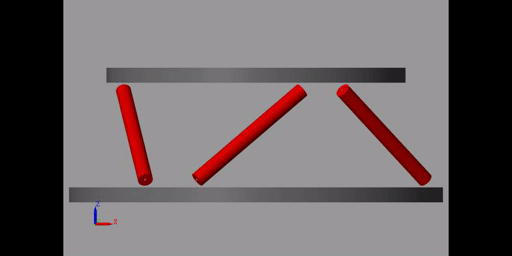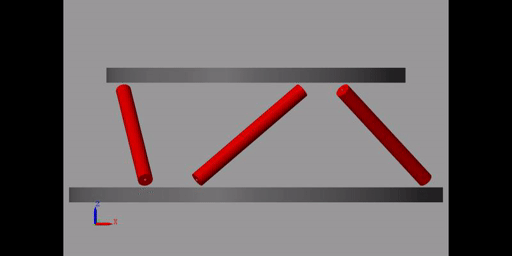Identification of the Stewart Platform using Simscape
Table of Contents
In this document, we discuss the various methods to identify the behavior of the Stewart platform.
1 Modal Analysis of the Stewart Platform
1.1 Initialize the Stewart Platform
stewart = initializeStewartPlatform(); stewart = initializeFramesPositions(stewart); stewart = generateGeneralConfiguration(stewart); stewart = computeJointsPose(stewart); stewart = initializeStrutDynamics(stewart); stewart = initializeJointDynamics(stewart, 'type_F', 'universal_p', 'type_M', 'spherical_p'); stewart = initializeCylindricalPlatforms(stewart); stewart = initializeCylindricalStruts(stewart); stewart = computeJacobian(stewart); stewart = initializeStewartPose(stewart); stewart = initializeInertialSensor(stewart);
ground = initializeGround('type', 'none'); payload = initializePayload('type', 'none');
1.2 Identification
%% Options for Linearized options = linearizeOptions; options.SampleTime = 0; %% Name of the Simulink File mdl = 'stewart_platform_model'; %% Input/Output definition clear io; io_i = 1; io(io_i) = linio([mdl, '/Controller'], 1, 'openinput'); io_i = io_i + 1; % Actuator Force Inputs [N] io(io_i) = linio([mdl, '/Relative Motion Sensor'], 1, 'openoutput'); io_i = io_i + 1; % Position/Orientation of {B} w.r.t. {A} io(io_i) = linio([mdl, '/Relative Motion Sensor'], 2, 'openoutput'); io_i = io_i + 1; % Velocity of {B} w.r.t. {A} %% Run the linearization G = linearize(mdl, io); % G.InputName = {'tau1', 'tau2', 'tau3', 'tau4', 'tau5', 'tau6'}; % G.OutputName = {'Xdx', 'Xdy', 'Xdz', 'Xrx', 'Xry', 'Xrz', 'Vdx', 'Vdy', 'Vdz', 'Vrx', 'Vry', 'Vrz'};
Let’s check the size of G:
size(G)
size(G)
State-space model with 12 outputs, 6 inputs, and 18 states.
'org_babel_eoe'
ans =
'org_babel_eoe'
We expect to have only 12 states (corresponding to the 6dof of the mobile platform).
Gm = minreal(G);
Gm = minreal(G); 6 states removed.
And indeed, we obtain 12 states.
1.3 Coordinate transformation
We can perform the following transformation using the ss2ss command.
Gt = ss2ss(Gm, Gm.C);
Then, the C matrix of Gt is the unity matrix which means that the states of the state space model are equal to the measurements \(\bm{Y}\).
The measurements are the 6 displacement and 6 velocities of mobile platform with respect to \(\{B\}\).
We could perform the transformation by hand:
At = Gm.C*Gm.A*pinv(Gm.C); Bt = Gm.C*Gm.B; Ct = eye(12); Dt = zeros(12, 6); Gt = ss(At, Bt, Ct, Dt);
1.4 Analysis
[V,D] = eig(Gt.A);
| Mode Number | Resonance Frequency [Hz] | Damping Ratio [%] |
|---|---|---|
| 1.0 | 780.6 | 0.4 |
| 2.0 | 780.6 | 0.3 |
| 3.0 | 903.9 | 0.3 |
| 4.0 | 1061.4 | 0.3 |
| 5.0 | 1061.4 | 0.2 |
| 6.0 | 1269.6 | 0.2 |
1.5 Visualizing the modes
To visualize the i’th mode, we may excite the system using the inputs \(U_i\) such that \(B U_i\) is co-linear to \(\xi_i\) (the mode we want to excite).
\[ U(t) = e^{\alpha t} ( ) \]
Let’s first sort the modes and just take the modes corresponding to a eigenvalue with a positive imaginary part.
ws = imag(diag(D)); [ws,I] = sort(ws) ws = ws(7:end); I = I(7:end);
for i = 1:length(ws)
i_mode = I(i); % the argument is the i'th mode
lambda_i = D(i_mode, i_mode);
xi_i = V(:,i_mode);
a_i = real(lambda_i);
b_i = imag(lambda_i);
Let do 10 periods of the mode.
t = linspace(0, 10/(imag(lambda_i)/2/pi), 1000); U_i = pinv(Gt.B) * real(xi_i * lambda_i * (cos(b_i * t) + 1i*sin(b_i * t)));
U = timeseries(U_i, t);
Simulation:
load('mat/conf_simscape.mat'); set_param(conf_simscape, 'StopTime', num2str(t(end))); sim(mdl);
Save the movie of the mode shape.
smwritevideo(mdl, sprintf('figs/mode%i', i), ... 'PlaybackSpeedRatio', 1/(b_i/2/pi), ... 'FrameRate', 30, ... 'FrameSize', [800, 400]);
end

Figure 1: Identified mode - 1

Figure 2: Identified mode - 3

Figure 3: Identified mode - 5
2 Transmissibility Analysis
2.1 Initialize the Stewart platform
stewart = initializeStewartPlatform(); stewart = initializeFramesPositions(stewart, 'H', 90e-3, 'MO_B', 45e-3); stewart = generateGeneralConfiguration(stewart); stewart = computeJointsPose(stewart); stewart = initializeStrutDynamics(stewart); stewart = initializeJointDynamics(stewart, 'type_F', 'universal_p', 'type_M', 'spherical_p'); stewart = initializeCylindricalPlatforms(stewart); stewart = initializeCylindricalStruts(stewart); stewart = computeJacobian(stewart); stewart = initializeStewartPose(stewart); stewart = initializeInertialSensor(stewart, 'type', 'accelerometer', 'freq', 5e3);
We set the rotation point of the ground to be at the same point at frames \(\{A\}\) and \(\{B\}\).
ground = initializeGround('type', 'rigid', 'rot_point', stewart.platform_F.FO_A); payload = initializePayload('type', 'rigid');
2.2 Transmissibility
%% Options for Linearized options = linearizeOptions; options.SampleTime = 0; %% Name of the Simulink File mdl = 'stewart_platform_model'; %% Input/Output definition clear io; io_i = 1; io(io_i) = linio([mdl, '/Disturbances/D_w'], 1, 'openinput'); io_i = io_i + 1; % Base Motion [m, rad] io(io_i) = linio([mdl, '/Absolute Motion Sensor'], 1, 'openoutput'); io_i = io_i + 1; % Absolute Motion [m, rad] %% Run the linearization T = linearize(mdl, io, options); T.InputName = {'Wdx', 'Wdy', 'Wdz', 'Wrx', 'Wry', 'Wrz'}; T.OutputName = {'Edx', 'Edy', 'Edz', 'Erx', 'Ery', 'Erz'};
freqs = logspace(1, 4, 1000); figure; for ix = 1:6 for iy = 1:6 subplot(6, 6, (ix-1)*6 + iy); hold on; plot(freqs, abs(squeeze(freqresp(T(ix, iy), freqs, 'Hz'))), 'k-'); set(gca, 'XScale', 'log'); set(gca, 'YScale', 'log'); ylim([1e-5, 10]); xlim([freqs(1), freqs(end)]); if ix < 6 xticklabels({}); end if iy > 1 yticklabels({}); end end end
From preumont07_six_axis_singl_stage_activ, one can use the Frobenius norm of the transmissibility matrix to obtain a scalar indicator of the transmissibility performance of the system:
\begin{align*} \| \bm{T}(\omega) \| &= \sqrt{\text{Trace}[\bm{T}(\omega) \bm{T}(\omega)^H]}\\ &= \sqrt{\Sigma_{i=1}^6 \Sigma_{j=1}^6 |T_{ij}|^2} \end{align*}freqs = logspace(1, 4, 1000); T_norm = zeros(length(freqs), 1); for i = 1:length(freqs) T_norm(i) = sqrt(trace(freqresp(T, freqs(i), 'Hz')*freqresp(T, freqs(i), 'Hz')')); end
And we normalize by a factor \(\sqrt{6}\) to obtain a performance metric comparable to the transmissibility of a one-axis isolator: \[ \Gamma(\omega) = \|\bm{T}(\omega)\| / \sqrt{6} \]
Gamma = T_norm/sqrt(6);
figure; plot(freqs, Gamma) set(gca, 'XScale', 'log'); set(gca, 'YScale', 'log');
3 Compliance Analysis
3.1 Initialize the Stewart platform
stewart = initializeStewartPlatform(); stewart = initializeFramesPositions(stewart, 'H', 90e-3, 'MO_B', 45e-3); stewart = generateGeneralConfiguration(stewart); stewart = computeJointsPose(stewart); stewart = initializeStrutDynamics(stewart); stewart = initializeJointDynamics(stewart, 'type_F', 'universal_p', 'type_M', 'spherical_p'); stewart = initializeCylindricalPlatforms(stewart); stewart = initializeCylindricalStruts(stewart); stewart = computeJacobian(stewart); stewart = initializeStewartPose(stewart); stewart = initializeInertialSensor(stewart, 'type', 'accelerometer', 'freq', 5e3);
We set the rotation point of the ground to be at the same point at frames \(\{A\}\) and \(\{B\}\).
ground = initializeGround('type', 'none'); payload = initializePayload('type', 'rigid');
3.2 Compliance
%% Options for Linearized options = linearizeOptions; options.SampleTime = 0; %% Name of the Simulink File mdl = 'stewart_platform_model'; %% Input/Output definition clear io; io_i = 1; io(io_i) = linio([mdl, '/Disturbances/F_ext'], 1, 'openinput'); io_i = io_i + 1; % Base Motion [m, rad] io(io_i) = linio([mdl, '/Absolute Motion Sensor'], 1, 'openoutput'); io_i = io_i + 1; % Absolute Motion [m, rad] %% Run the linearization C = linearize(mdl, io, options); C.InputName = {'Fdx', 'Fdy', 'Fdz', 'Mdx', 'Mdy', 'Mdz'}; C.OutputName = {'Edx', 'Edy', 'Edz', 'Erx', 'Ery', 'Erz'};
freqs = logspace(1, 4, 1000); figure; for ix = 1:6 for iy = 1:6 subplot(6, 6, (ix-1)*6 + iy); hold on; plot(freqs, abs(squeeze(freqresp(C(ix, iy), freqs, 'Hz'))), 'k-'); set(gca, 'XScale', 'log'); set(gca, 'YScale', 'log'); ylim([1e-10, 1e-3]); xlim([freqs(1), freqs(end)]); if ix < 6 xticklabels({}); end if iy > 1 yticklabels({}); end end end
We can try to use the Frobenius norm to obtain a scalar value representing the 6-dof compliance of the Stewart platform.
freqs = logspace(1, 4, 1000); C_norm = zeros(length(freqs), 1); for i = 1:length(freqs) C_norm(i) = sqrt(trace(freqresp(C, freqs(i), 'Hz')*freqresp(C, freqs(i), 'Hz')')); end
figure; plot(freqs, C_norm) set(gca, 'XScale', 'log'); set(gca, 'YScale', 'log');
4 Functions
4.1 Compute the Transmissibility
Function description
function [T, T_norm, freqs] = computeTransmissibility(args) % computeTransmissibility - % % Syntax: [T, T_norm, freqs] = computeTransmissibility(args) % % Inputs: % - args - Structure with the following fields: % - plots [true/false] - Should plot the transmissilibty matrix and its Frobenius norm % - freqs [] - Frequency vector to estimate the Frobenius norm % % Outputs: % - T [6x6 ss] - Transmissibility matrix % - T_norm [length(freqs)x1] - Frobenius norm of the Transmissibility matrix % - freqs [length(freqs)x1] - Frequency vector in [Hz]
Optional Parameters
arguments
args.plots logical {mustBeNumericOrLogical} = false
args.freqs double {mustBeNumeric, mustBeNonnegative} = logspace(1,4,1000)
end
freqs = args.freqs;
Identification of the Transmissibility Matrix
%% Options for Linearized options = linearizeOptions; options.SampleTime = 0; %% Name of the Simulink File mdl = 'stewart_platform_model'; %% Input/Output definition clear io; io_i = 1; io(io_i) = linio([mdl, '/Disturbances/D_w'], 1, 'openinput'); io_i = io_i + 1; % Base Motion [m, rad] io(io_i) = linio([mdl, '/Absolute Motion Sensor'], 1, 'openoutput'); io_i = io_i + 1; % Absolute Motion [m, rad] %% Run the linearization T = linearize(mdl, io, options); T.InputName = {'Wdx', 'Wdy', 'Wdz', 'Wrx', 'Wry', 'Wrz'}; T.OutputName = {'Edx', 'Edy', 'Edz', 'Erx', 'Ery', 'Erz'};
If wanted, the 6x6 transmissibility matrix is plotted.
p_handle = zeros(6*6,1); if args.plots fig = figure; for ix = 1:6 for iy = 1:6 p_handle((ix-1)*6 + iy) = subplot(6, 6, (ix-1)*6 + iy); hold on; plot(freqs, abs(squeeze(freqresp(T(ix, iy), freqs, 'Hz'))), 'k-'); set(gca, 'XScale', 'log'); set(gca, 'YScale', 'log'); if ix < 6 xticklabels({}); end if iy > 1 yticklabels({}); end end end linkaxes(p_handle, 'xy') xlim([freqs(1), freqs(end)]); ylim([1e-5, 1e2]); han = axes(fig, 'visible', 'off'); han.XLabel.Visible = 'on'; han.YLabel.Visible = 'on'; ylabel(han, 'Frequency [Hz]'); xlabel(han, 'Transmissibility [m/m]'); end
Computation of the Frobenius norm
T_norm = zeros(length(freqs), 1); for i = 1:length(freqs) T_norm(i) = sqrt(trace(freqresp(T, freqs(i), 'Hz')*freqresp(T, freqs(i), 'Hz')')); end
T_norm = T_norm/sqrt(6);
if args.plots figure; plot(freqs, T_norm) set(gca, 'XScale', 'log'); set(gca, 'YScale', 'log'); xlabel('Frequency [Hz]'); ylabel('Transmissibility - Frobenius Norm'); end
4.2 Compute the Compliance
Function description
function [C, C_norm, freqs] = computeCompliance(args) % computeCompliance - % % Syntax: [C, C_norm, freqs] = computeCompliance(args) % % Inputs: % - args - Structure with the following fields: % - plots [true/false] - Should plot the transmissilibty matrix and its Frobenius norm % - freqs [] - Frequency vector to estimate the Frobenius norm % % Outputs: % - C [6x6 ss] - Compliance matrix % - C_norm [length(freqs)x1] - Frobenius norm of the Compliance matrix % - freqs [length(freqs)x1] - Frequency vector in [Hz]
Optional Parameters
arguments
args.plots logical {mustBeNumericOrLogical} = false
args.freqs double {mustBeNumeric, mustBeNonnegative} = logspace(1,4,1000)
end
freqs = args.freqs;
Identification of the Compliance Matrix
%% Options for Linearized options = linearizeOptions; options.SampleTime = 0; %% Name of the Simulink File mdl = 'stewart_platform_model'; %% Input/Output definition clear io; io_i = 1; io(io_i) = linio([mdl, '/Disturbances/F_ext'], 1, 'openinput'); io_i = io_i + 1; % External forces [N, N*m] io(io_i) = linio([mdl, '/Absolute Motion Sensor'], 1, 'openoutput'); io_i = io_i + 1; % Absolute Motion [m, rad] %% Run the linearization C = linearize(mdl, io, options); C.InputName = {'Fdx', 'Fdy', 'Fdz', 'Mdx', 'Mdy', 'Mdz'}; C.OutputName = {'Edx', 'Edy', 'Edz', 'Erx', 'Ery', 'Erz'};
If wanted, the 6x6 transmissibility matrix is plotted.
p_handle = zeros(6*6,1); if args.plots fig = figure; for ix = 1:6 for iy = 1:6 p_handle((ix-1)*6 + iy) = subplot(6, 6, (ix-1)*6 + iy); hold on; plot(freqs, abs(squeeze(freqresp(C(ix, iy), freqs, 'Hz'))), 'k-'); set(gca, 'XScale', 'log'); set(gca, 'YScale', 'log'); if ix < 6 xticklabels({}); end if iy > 1 yticklabels({}); end end end linkaxes(p_handle, 'xy') xlim([freqs(1), freqs(end)]); han = axes(fig, 'visible', 'off'); han.XLabel.Visible = 'on'; han.YLabel.Visible = 'on'; xlabel(han, 'Frequency [Hz]'); ylabel(han, 'Compliance [m/N, rad/(N*m)]'); end
Computation of the Frobenius norm
freqs = args.freqs; C_norm = zeros(length(freqs), 1); for i = 1:length(freqs) C_norm(i) = sqrt(trace(freqresp(C, freqs(i), 'Hz')*freqresp(C, freqs(i), 'Hz')')); end
if args.plots figure; plot(freqs, C_norm) set(gca, 'XScale', 'log'); set(gca, 'YScale', 'log'); xlabel('Frequency [Hz]'); ylabel('Compliance - Frobenius Norm'); end